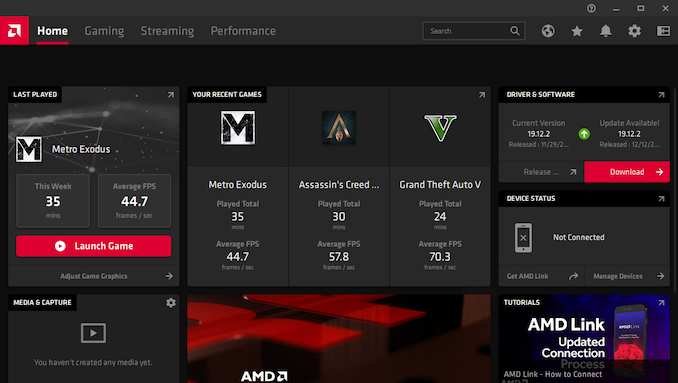The AMD Radeon RX 5500 XT Review, Feat. Sapphire Pulse: Navi For 1080p
by Ryan Smith on December 12, 2019 9:00 AM ESTThe Test
As is usually the case for launches without reference hardware, we’ve had to dial down our Sapphire cards slightly to meet AMD’s reference specifications. In this case, Sapphire’s secondary BIOS offers reference settings, so for our reference-spec testing, we’re using that BIOS. Otherwise, for at-stock testing of the Sapphire Pulse RX 5500 XT 8GB, that is being done with the primary (performance) BIOS.
Meanwhile on the driver front, we’re using AMD’s new Radeon Software Adrenaline Edition 19.2.2 software set, which are the launch drivers for the RX 5500 XT. AMD has introduced a number of control panel features here (not to mention a UI overhaul) that we’ll cover in a separate article. Otherwise for performance testing, these drivers are not substantially different from earlier AMD drivers – though we’ve retested the RX 570 and RX 5700 to ensure those results are fully up to date.
Finally, as the RX 5500 series is focused on 1080p gaming, this is what our benchmark results will focus on. I have also tested the RX 5500 XT 8GB at our 1440p settings – as expected, it’s not very playable there – and while these results haven’t been graphed, they are available in our Bench system.
| CPU: | Intel Core i9-9900K @ 5.0GHz |
| Motherboard: | ASRock Z390 Taichi |
| Power Supply: | Corsair AX1200i |
| Hard Disk: | Phison E12 PCIe NVMe SSD (960GB) |
| Memory: | G.Skill Trident Z RGB DDR4-3600 2 x 16GB (17-18-18-38) |
| Case: | NZXT Phantom 630 Windowed Edition |
| Monitor: | Asus PQ321 |
| Video Cards: | AMD Radeon RX 5700 Sapphire Pulse RX 5500 XT 8GB Sapphire Pulse RX 5500 XT 4GB AMD Radeon RX 580 AMD Radeon RX 570 AMD Radeon RX 460 4GB AMD Radeon R9 380 NVIDIA GeForce GTX 1660 Super NVIDIA GeForce GTX 1660 NVIDIA GeForce GTX 1650 Super NVIDIA GeForce GTX 1060 3GB |
| Video Drivers: | NVIDIA Release 441.41 NVIDIA Release 441.07 AMD Radeon Software Adrenalin 2020 Edition 19.12.2 AMD Radeon Software Adrenalin 2019 Edition 19.10.2 |
| OS: | Windows 10 Pro (1903) |











97 Comments
View All Comments
qwertymac93 - Sunday, December 15, 2019 - link
As this card is based on the same RDNA1 architecture as the 5700 series AMD has had months to optimize performance. It isn't likely the overall rankings will change much unless the new consoles bring a major shift in game developer optimization priorities.peevee - Monday, December 16, 2019 - link
"the company is also bundling the forthcoming “Master Edition” of Monster Hunter: Iceborne. This is the Iceborne expansion bundled with the base game"They'd better reduce price by $10-20 to be price-competitive with 1650 Super.
marees - Wednesday, December 18, 2019 - link
Given the average performance value of this card, it seems to me gamers who want a budget card for 1080p are better off, waiting for the xbox series S !?Korguz - Wednesday, December 18, 2019 - link
and what if the games the person plays.. are not on a console ? then what ?peevee - Friday, December 20, 2019 - link
So why would you prefer this over 1660?kayfabe - Tuesday, December 24, 2019 - link
Because the 4gb version is ~$30 cheaper and some gamers like monster hunter or quiet computing. The bottom line is that these products are far enough down the pricing totem pole that a good rebate or bundle can sway people pretty easily--at this range you're hunting minimally enjoyable functionality, not future proofing. Personally, I'm holding out until at least ampere arrives before I start throwing money around again.toke - Saturday, August 8, 2020 - link
Anybody seen any comparisons of IDLE power use of real cards?I'd like to choose the one with least among 570, 580, 590 or 5500.
Are all the reviews like this one, idle power use against manuf. ref. cards?